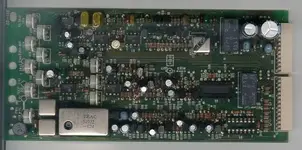evm1024
New member
The relay replacement is good
I got a little time to put in the Omron G5v-2-H1-DC24 relays as replacement for the original NEC. I can say that they work fine.
I've only found time to replace the relays and blown CMOS ICs on 6 of the 16 cards so far. Just too many other things to do. But, I thought to get this info in the thread should anyone be interested.
I use a good 15 watt iron and a typical solder sucker from RS. The metal shield that fits over the relays comes off easily as do the relays if you get a good "suck". If not then a little reheating goes a long way. Just be gentle.
Pulling the dead IC presents a greater degree of work as that on is 14 pins and the other 16. All in all it takes 30+ minutes per card to remove the shields, relays, dead ICs and then install sockets, new relays and replace the shield and socket the ICs.
Don't leave the shields off as that they help prevent crosstalk and stray hum pickup. They after all switch the heads to the input amp and record drive amp.
As always work carefully and stop when you find your attention not where it should be. I get tired and need to do something else....
My plan has been to work on this deck in stages. Stage 1 is to get it all working and calibrated to spec.
Stage 2 will be to change the bias level to allow calibration to 370 nW/M.
Stage 3 will be to upgrade opamps, EQ caps and feedback resistors.
Regards, Ethan
PS here is a photo of the relays and sockets in place but before putting the shields back on or replacing the ICs.
I have a spare card from TallDog (thanks again) and I note that someone before him replaced the relays and an IC. They left the shields off and installed the socket backwards....Oops! Let's not do that to ourselves.
I got a little time to put in the Omron G5v-2-H1-DC24 relays as replacement for the original NEC. I can say that they work fine.
I've only found time to replace the relays and blown CMOS ICs on 6 of the 16 cards so far. Just too many other things to do. But, I thought to get this info in the thread should anyone be interested.
I use a good 15 watt iron and a typical solder sucker from RS. The metal shield that fits over the relays comes off easily as do the relays if you get a good "suck". If not then a little reheating goes a long way. Just be gentle.
Pulling the dead IC presents a greater degree of work as that on is 14 pins and the other 16. All in all it takes 30+ minutes per card to remove the shields, relays, dead ICs and then install sockets, new relays and replace the shield and socket the ICs.
Don't leave the shields off as that they help prevent crosstalk and stray hum pickup. They after all switch the heads to the input amp and record drive amp.
As always work carefully and stop when you find your attention not where it should be. I get tired and need to do something else....
My plan has been to work on this deck in stages. Stage 1 is to get it all working and calibrated to spec.
Stage 2 will be to change the bias level to allow calibration to 370 nW/M.
Stage 3 will be to upgrade opamps, EQ caps and feedback resistors.
Regards, Ethan
PS here is a photo of the relays and sockets in place but before putting the shields back on or replacing the ICs.
I have a spare card from TallDog (thanks again) and I note that someone before him replaced the relays and an IC. They left the shields off and installed the socket backwards....Oops! Let's not do that to ourselves.



 I can't tell if one cover was removed at one point or not. When I cleaned my relays I pulled the one cover off of each and put it back. Wasn't really a big deal, and made a big deifference in the machines mechanical response to monitoring source changes (i.e. switching from input to sync to repro).
I can't tell if one cover was removed at one point or not. When I cleaned my relays I pulled the one cover off of each and put it back. Wasn't really a big deal, and made a big deifference in the machines mechanical response to monitoring source changes (i.e. switching from input to sync to repro).


